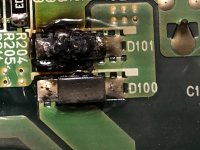This on the backside of a diesel forklift ECU (computer engine control) board. As you can see it overheated and is now short in both directions. I'm assuming D stands for diode but the other identical appearance components are not conducting in either direction....could D stand for something else in this case ?
Also any hints on what the specs might be for replacement ? On some of the good ones I can barely make out the numbers 76 and 14 (size 7614 ?)



Also any hints on what the specs might be for replacement ? On some of the good ones I can barely make out the numbers 76 and 14 (size 7614 ?)





